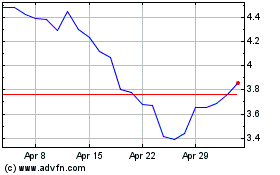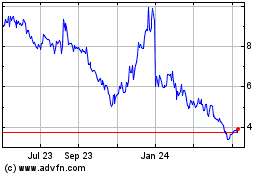Anavex Life Sciences Corp. (“Anavex” or the “Company”) (Nasdaq:
AVXL), a clinical-stage biopharmaceutical company developing
differentiated therapeutics for the treatment of neurodegenerative
and neurodevelopmental disorders, including Alzheimer's disease,
Parkinson's disease, Rett syndrome, and other central nervous
system (CNS) diseases, today reported a new peer-reviewed
publication in the journal Neurobiology of Aging, titled “Early
treatment with an M1 and sigma-1 receptor agonist prevents
cognitive decline in a transgenic rat model displaying
Alzheimer-like amyloid pathology”, featuring the orally available
small molecule ANAVEX®3-71 (AF710B).1
This study ascertains potential
disease-modifying properties of ANAVEX®3-71 (AF710B) on Alzheimer’s
disease (AD) pathology and could be a drug candidate for a once
daily oral preventive strategy.
ANAVEX®3-71 activates the sigma-1 receptor
(SIGMAR1) and the M1 muscarinic receptor (M1R). Data suggests that
activation of SIGMAR1 results in the restoration of homeostatic
function within the body and is pivotal to restoring neural cell
balance and promoting neuroplasticity.2 Previous studies of
ANAVEX®3-71 have demonstrated its potential to treat Alzheimer’s
disease (AD)-like pathology at advanced stages of disease in animal
models.3,4
ANAVEX®3-71, an orally available small molecule,
has already successfully completed a Phase 1 human clinical trial
demonstrating good safety and tolerability signals at all doses
studied.5
In this publication, transgenic rats that
develop AD-like symptoms as they age were treated with ANAVEX®3-71
for 7-months before they developed amyloid plaques, followed by a
4-week washout period. Preventative treatment with ANAVEX®3-71
reduced levels of insoluble and soluble amyloid-beta as well as
plaque deposition in the aging cortex and hippocampus, areas
heavily impacted by AD. Notably, the reduction in amyloid pathology
was accompanied by a reduction in inflammatory glial activity which
is connected to the disease cascade in AD and other dementias.
ANAVEX®3-71 treatment downregulated the proinflammatory IL-1β and
IL-6 cytokines, which are known to be associated with AD.
Additionally, ANAVEX®3-71 treatment boosted brain derived
neurotrophic factor (BDNF) which reinforces the evidence that
ANAVEX®3-71 protects neurons.
Importantly, these beneficial effects
were sustained after a month-long drug washout. This
differentiates ANAVEX®3-71 from other therapeutic approaches and
suggests long-lasting, disease-modifying effects on AD pathology.
This long-lasting effect was also observed in previous animal
studies of ANAVEX®3-71 at advanced stages of the disease.
The publication is consistent with previous
scientific findings, including with the more advanced drug
candidate ANAVEX®2-73 (blarcamesine), which successfully completed
a Phase 2b/3 study in early Alzheimer’s disease, that SIGMAR1
activation acts upstream of multiple contributors to AD and other
dementias including but not limited to mitochondrial dysfunction6,
oxidative stress7, impaired autophagy8 and that amyloid pathology
can be reduced by M1R stimulation9.
The authors of the paper (Neurobiology of Aging
132 (2023) 220–232) from the Laboratory of Professor Cuello, MD at
McGill University concluded: “This involved study could be
considered as proof of principle for preventive therapies in
Alzheimer’s disease and illustrates that this category of
compounds, or similar effective agents, could be considered as
candidates for preventive strategies to slow down the early amyloid
pathology in Alzheimer’s disease, a condition that is increasingly
diagnosed at preclinical stages.”
“This publication is a confirmation of the
scientific depth of Anavex’s upstream SIGMAR1 platform, which gives
hope to the Alzheimer’s disease community, especially for the
patients, families and caregivers who fight everyday against this
devastating disease for a potential disease-modifying drug
candidate with a once daily oral preventive strategy. We also look
forward to presenting in an upcoming major publication the complete
dataset of the Phase 2b/3 Alzheimer’s disease trial of ANAVEX®2-73
(blarcamesine), a potential next-generation precision medicine
convenient once daily oral Alzheimer’s disease treatment,” said
Christopher U Missling, PhD, President and Chief Executive Officer
of Anavex. "We are also on track within our neurodevelopmental
precision medicine Rett syndrome program to release top-line data
of ANAVEX®2-73-RS-003 Phase 2/3 EXCELLENCE pediatric clinical trial
in the current quarter of 2023.”
About Anavex Life Sciences Corp.
Anavex Life Sciences Corp. (Nasdaq: AVXL) is a
publicly traded biopharmaceutical company dedicated to the
development of novel therapeutics for the treatment of
neurodegenerative and neurodevelopmental disorders, including
Alzheimer's disease, Parkinson's disease, Rett syndrome, and other
central nervous system (CNS) diseases, pain, and various types of
cancer. Anavex's lead drug candidate, ANAVEX®2-73 (blarcamesine),
has successfully completed a Phase 2a and a Phase 2b/3 clinical
trial for Alzheimer's disease, a Phase 2 proof-of-concept study in
Parkinson's disease dementia, and both a Phase 2 and a Phase 3
study in adult patients with Rett syndrome. ANAVEX®2-73 is an
orally available drug candidate that restores cellular homeostasis
by targeting sigma-1 and muscarinic receptors. Preclinical studies
demonstrated its potential to halt and/or reverse the course of
Alzheimer's disease. ANAVEX®2-73 also exhibited anticonvulsant,
anti-amnesic, neuroprotective, and anti-depressant properties in
animal models, indicating its potential to treat additional CNS
disorders, including epilepsy. The Michael J. Fox Foundation for
Parkinson's Research previously awarded Anavex a research grant,
which fully funded a preclinical study to develop ANAVEX®2-73 for
the treatment of Parkinson's disease. ANAVEX®3-71, which targets
sigma-1 and M1 muscarinic receptors, is a promising clinical stage
drug candidate demonstrating disease-modifying activity against the
major hallmarks of Alzheimer's disease in transgenic (3xTg-AD)
mice, including cognitive deficits, amyloid, and tau pathologies.
In preclinical trials, ANAVEX®3-71 has shown beneficial effects on
mitochondrial dysfunction and neuroinflammation. Further
information is available at www.anavex.com. You can also connect
with the Company on Twitter, Facebook, Instagram, and LinkedIn.
Forward-Looking Statements
Statements in this press release that are not
strictly historical in nature are forward-looking statements. These
statements are only predictions based on current information and
expectations and involve a number of risks and uncertainties.
Actual events or results may differ materially from those projected
in any of such statements due to various factors, including the
risks set forth in the Company’s most recent Annual Report on Form
10-K filed with the SEC. Readers are cautioned not to place undue
reliance on these forward-looking statements, which speak only as
of the date hereof. All forward-looking statements are qualified in
their entirety by this cautionary statement and Anavex Life
Sciences Corp. undertakes no obligation to revise or update this
press release to reflect events or circumstances after the date
hereof.
For Further Information:Anavex
Life Sciences Corp.Research & Business DevelopmentToll-free:
1-844-689-3939Email: info@anavex.com
Investors:Andrew J.
BarwickiInvestor Relations
Tel: 516-662-9461Email: andrew@barwicki.com
1 Orciani C, Do Carmo S, Foret MK, et al. Early treatment with
an M1 and sigma-1 receptor agonist prevents cognitive decline in a
transgenic rat model displaying Alzheimer-like amyloid pathology
[published online ahead of print, 2023 Sep 26]. Neurobiol Aging.
2023;132:220-232. doi:10.1016/j.neurobiolaging.2023.09.0102
Advances in Experimental Medicine and Biology Volume 964 (2017)
Sigma Receptors: Their Role in Disease and as Therapeutic Targets.3
Fisher A, Bezprozvanny I, Wu L, et al. AF710B, a Novel M1/σ1
Agonist with Therapeutic Efficacy in Animal Models of Alzheimer’s
Disease. Neurodegener Dis. 2016;16(1-2):95-110.
doi:10.1159/0004408644 Hall H, Iulita MF, Gubert P, et al. AF710B,
an M1/sigma-1 receptor agonist with long-lasting disease-modifying
properties in a transgenic rat model of Alzheimer's disease.
Alzheimers Dement. 2018;14(6):811-823.
doi:10.1016/j.jalz.2017.11.0095 Fadiran EO, Hammond E, Tran J, et
al. Concentration-QTc Relationship from a Single Ascending Dose
Study of ANAVEX3-71, a Novel Sigma-1 Receptor and Allosteric M1
Muscarinic Receptor Agonist in Development for the Treatment of
Frontotemporal Dementia, Schizophrenia, and Alzheimer's Disease.
Clin Pharmacol Drug Dev. 2023;12(9):888-901. doi:10.1002/cpdd.13036
Lahmy, V., Long, R., Morin, D., Villard, V., Maurice, T., 2014.
Mitochondrial protection by the mixed muscarinic/sigma1 ligand
ANAVEX2-73, a tetrahydrofuran derivative, in Aβ25-35
peptide-injected mice, a nontransgenic Alzheimer’s disease model.
Front. Cell. Neurosci. 8, 463.
https://doi.org/10.3389/fncel.2014.004637 Arimon, M., Takeda, S.,
Post, K.L., Svirsky, S., Hyman, B.T., Berezovska, O., 2015.
Oxidative stress and lipid peroxidation are upstream of amyloid
pathology. Neurobiol. Dis. 84, 109–119.
https://doi.org/10.1016/j.nbd.2015.06.0138 Christ MG, Clement AM,
Behl C. The Sigma-1 Receptor at the Crossroad of Proteostasis,
Neurodegeneration, and Autophagy. Trends Neurosci.
2020;43(2):79-81. doi:10.1016/j.tins.2019.12.0029 Zhao LX, Chen MW,
Qian Y, Yang QH, Ge YH, Chen HZ, Qiu Y. M1 Muscarinic Receptor
Activation Rescues β-Amyloid-Induced Cognitive Impairment through
AMPA Receptor GluA1 Subunit. Neuroscience. 2019 Jun 1;408:239-247.
doi: 10.1016/j.neuroscience.2019.04.007. Epub 2019 Apr 11. PMID:
30981860
Anavex Life Sciences (NASDAQ:AVXL)
Historical Stock Chart
From Jun 2024 to Jul 2024

Anavex Life Sciences (NASDAQ:AVXL)
Historical Stock Chart
From Jul 2023 to Jul 2024
